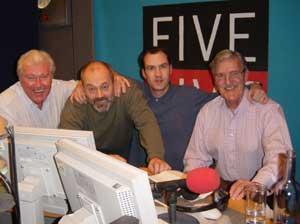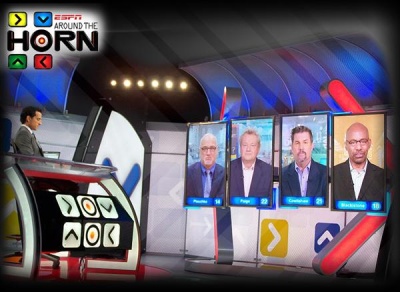Weaver's Week 2011-04-24
Last week | Weaver's Week Index | Next week
In a very special Week, we pit two of the most available English-language sports punditry competitions against each other. Two shows enter, only one will be deemed good entertainment. Unless neither does. Or they both do. (Bundles notes into a ball and throws them at a bell.)
Contents |
Fighting Talk
World's End for Radio 5, since October 2003
It's seven-and-a-half years since Fighting Talk first burst onto the nation's airwaves, and seven-and-a-half years since this column thought, "Must get round to reviewing it some day." A lot has happened in the intervening period, Sam and Mark have gone from Pop Idol through the pop charts and TMi and Copycats (1) to Choir Idol and Copycats (2), and we've never got round to reviewing it. Until now.
The sample episode we reviewed was broadcast on 26 March, and featured Colin Murray as the host. Murray is the third regular host of Fighting Talk, having assumed the helm in 2006, and this job has helped to ease his transition from Radio 1 DJ into a moderately-credible sports presenter. Without Fighting Talk, we doubt that Murray would be the face of Channel 5's coverage of the European League football.
The basic format of Fighting Talk is simple. Four commentators join Murray, and they'll spend the hour discussing sport. On the episode we heard, the quartet was John Rawling from the brawling, Martin Kelner from Leeds, Ian Stone from Arsenal, and Greg Brady from Toronto. The show begins with Murray introducing the panel, and telling us a lot about the panel. Probably too much, the introduction is longer than even some of the introductory spiel on I'm Sorry I Haven't a Clue.
Eventually, we're kicking off with round one. In this round, Colin Murray declares a subject for discussion, in this case discussing the Wales v England football match played later that day. In turn, each of the pundits will give his opinion. During this round, Murray plays in various sound effects. These form the show's scoring system – apparently, a "ding" is worth one point, a "thwack" counts double, and a snatch of the "Hallelujah" chorus presages the award of three points. Or the entrance of Professor Emil Burkiss, we're not sure which.
As with any long-running programme, a mythology has developed around Fighting Talk. In this case, the accepted story is that points are awarded for "good" sporting punditry, however that's defined. Apparently, it's saying things that are a bit novel, slightly out of the ordinary, something that will create a reaction in the listener. Opinions that regurgitate received wisdom on a subject are marked down, and may receive a "raspberry" noise that marks a one-point penalty. Contestants are expected to speak for about 45 seconds on their topic, without much interruption from the rest of the panel, and are marked down if they become repetitive or bore the host. It's quickly apparent that the marking in this round is entirely subjective, at the whim of the host.
Round two is similar to round one, in that the contestants are asked to pontificate on a subject. There is a very slight difference from the prior round, as the subject is suggested by a listener. While the host awards points in the same round as before, the listener who set the question is allowed to award two bonus points for the answer they felt was "best".
The rest of the programme follows in a very similar pattern: the subject changes every five minutes or so, and Murray awards points based on his impression of the contribution. Fighting Talk isn't a debate show per se, few if any scores are made from the interaction by the contestants.
By virtue of being a live show on the BBC's nominal news and sport programme, Fighting Talk is interrupted by two travel bulletins, and by a bulletin of news and sport on the half-hour. These provide punctuation, an excuse to recap the scores, and the longer bulletin is followed by the Golden Envelope round. In addition to the established points issued at the whim of the host, a bonus of 10 points is available if contestants can match – exactly – the answer Murray has written down and secreted in the envelope.
Throughout the programme, Murray spices up the programme by the use of sound effects. As we've already discussed, some of them are to do with the scoring. Others are snatches of popular song or sound effects to do with the topic under discussion, or regarding the names of the panellists. There are also sounds for good jokes, bad jokes, and no adequately-explored reason.
The beginning of the end of the show is marked by the "Any Other Business" round. Here, the airwaves are thrown open for each of the pundits to pontificate about a subject dear to their heart. On our sample show, Brady used the previous day's vote of no-confidence in the Harper government to propose a vote of no-confidence in football managers, while Kelner delivered a diatribe against those suitcases with little wheels. Again, these are marked by the host according to his whimsical scheme.
Once the Any Other Business round is completed, the score is totted up for the final time. The top two contenders are then asked to compete in the day's final round, "Defend the Indefensible". Here, the task is to take an unpopular, absurd, or otherwise implausible statement, and justify it to the sceptical host. The aim is to continue talking, coherently and sensibly, about this subject while a 20-second jingle plays out. Failure is liable to forfeit the game to another player; the game will be judged on success in this round and the prior contest.
 Original host Johnny Vaughan (3rd from left) with a 2003 panel.
Original host Johnny Vaughan (3rd from left) with a 2003 panel.
In short, the game of Fighting Talk is entirely decided on the whim of the presenter, sufficiently so that we need to consider it as an entertainment rather than a serious competition. Therefore, the first question is whether the show does actually entertain, if it does really work as a fun show. We're not entirely sure. Certainly, themes develop spontaneously through the programme – in our sample episode, someone mentioned picnic hampers in one of the early rounds, causing it to appear in almost every round thereafter. We've no doubt that there are running jokes for regular listeners, little pieces of Fighting Talk culture that are invisible to the uninitiated.
It seems that the programme stands or falls on the quality of its guest bookings, and how well the pundits are able to (er) pundit. The quartet in our sample episode were well-trained in the art of Fighting Talk, which makes for good entertainment. Are new panellists able to achieve such quality quickly? If they're not, the show would disappear into an insularity of its own making. The evidence suggests that fate has been avoided, explaining the programme's longevity.
We're floundering. To find out whether Fighting Talk really is good, we need a point of comparison. Which brings us to...
Around The Horn
ESPN (US), since 2002
Shown in the UK when NASN has nothing better to show.
This review is based on the podcast (audio only) of the episodes from 23 and 30 March.
Around the Horn is a 22-minute television programme, in which the host and four guests discuss the most high-profile sports stories of the day, as seen from the Chesapeake Drainage Area. The programme's host is Tony Reali (that's pronounced re-all-ey), and he introduces four panellists live via video link from their home cities. According to the show blurb, the show aims to look at things from a regional point of view, not just as things seem from ESPN's headquarters in Bristol. Which is curious, seeing as how the show is based some hundreds of miles away.
Each show has a rigid format, beginning with introductions and opening statements from each competitor. Round two, confusingly called "The First Word", discusses a topic making headlines in ESPN's world of sport. Unlike Fighting Talk, the format allows for and encourages cross-talk between the panellists after each has made a statement. The contributions are a little shorter. Round three, still "The First Word", has another ESPN headline story. Each story is introduced by a montage of clips and recent action; this might work well on the television, but not so well in the audio version.
After the first commercial break, round four is "Buy or Sell", in which each panellist is asked to propose or oppose an idea, riffing off one of the sports stories of the day. Three different topics will be played, and each rotation will last for not much more than a minute. After this, the contestant with the lowest score is eliminated from competition, and the show goes to another commercial break.
After this comes "The Lightning Round", fast discussion on two or three topics. Already, the game has been played at a frantic pace, five discussions have been completed in about fifteen minutes, but now it heads for the end at warp speed. The lowest score after this round is eliminated, and there's another commercial break.
Two players make it through to the daily final, "The Showdown". This has the remaining contestants discussing a couple of topics, arguing for 20 seconds. That's 20 seconds between them, not each. The prize for the winner is the final round, "Facetime", a chance to speak directly to the audience about a topic close to the winner's heart. It's almost like the "Any Other Business" round, without the judging.
Scoring is at the whim of the host: decent arguments get rewarded with points, the better the punditry, the more points are awarded. Scores are signified by a quiet boop-boop, and there's probably on-screen some graphic to go with it. Contestants can have points deducted, but this also causes their microphone to be muted for about ten seconds. Around the Horn regularly gives additional points for previously unpublished information relevant to the topic under discussion; we didn't experience this on Fighting Talk.
Again, there are running jokes and stylistic points – the shows opened with riffs on "Four of America's most [adjective] sportswriters", and the final was introduced with the portentous "Two men enter, one man ...", before descending into bathos. "Two men enter, one man gets a rubber duck", that kind of thing. The titular horn sounds to mark the beginning of the end of each discussion, that the panellists should draw their remarks to a conclusion fairly quickly.
Now, we mentioned that Around the Horn goes quickly. Sometimes, it's too quick: one of the sample episodes spent both halves of "The First Word" discussing a basketball player who had absented himself from the team parade just before a game. From the contributions by the panellists, we can conclude that the player had had previous contretemps with someone else at this location. We're not sure whether it was a manager, another player, a fan. Around the Horn assumes that its listeners are already au fait with the ongoing stories in ESPN's world of sport, and when we're not, the discussions make little to no sense. This column is too close to Fighting Talk's native culture to make a reasonable call on whether a similar criticism could be levelled at that programme.
The speed of the show also reflects in the contributions each player is able to make: particularly after the opening segment, arguments are restricted to about ten seconds. Ten seconds. There are questions on Mastermind longer and more detailed than arguments on Around the Horn. It's barely enough time to express and explain one thought, never mind come up with a complex model that interconnects the failure of the Minnesota Airheads of baseball with the success of CSKA Kensington of football and the continued existence of violet in the spectrum. Around the Horn only allows for the most facile, the most glib argument, barely skimming the surface of a topic. By going at a significantly slower pace, Fighting Talk allows for arguments of a higher quality to be developed. That's not to say the panel will develop them, but the opportunity is there.
Finally, Around the Horn is no more than a talking shop. Opinionated people are given part of a 22-minute programme to talk about nine or ten sports topics as they see fit. There's no way in which the panellists are asked to stop and think about what they're saying, asked to consider ways in which they might be wrong. The "Buy or Sell" round asks for the panel's opinion and reasons to back up that view, it doesn't ask them to argue the other way. "Defend the Indefensible" on Fighting Talk will stretch the contributors, by requiring them to make arguments they've not previously rehearsed.
Both programmes are clearly less spontaneous than they might appear – we've no doubt that the contributors are briefed a little before airtime about the topics destined to appear in that transmission, so that they can scribble some notes, perhaps research some footage. This only serves to enhance the experience, albeit by slightly increasing the artificiality of the experience.
The million-lira question: would we choose to listen to these programmes again? Not regularly, is the honest answer. For Fighting Talk, that's because we find discussion of English football gets tedious in a very short while, and over half of the programme asked for opinions on that particular pastime. Around the Horn we found a little too fast to be enjoyable. Both programmes require concentration, perhaps more than we can regularly give radio programmes. But, as something different, on a long train ride where we're gazing out of the window and don't fancy hearing archive comedy, we can see these shows filling a decent little gap.
This Week And Next
Simon Cowell confirmed that he wouldn't be fronting this year's edition of The X Factor, which is scheduled to begin in August and go on and on and on until the end of the year. Mr. Cowell will, instead, be fronting the show in its North American version. According to an ITV spokesperson, "Simon will still be prominent behind the scenes", so we expect to see him credited as Key Grip or somesuch.
Ratings news for the week to 10 April show that Have I Got News For You is back, and it's got 5.15m people watching. That's more than Masterchef's 5.05m, and Secret Fortune comes third with 4.4m viewers. Total Wipeout's celebrity special was seen by 3.8m, and the University Challenge final 3.35m. Can Jeremy Paxman prove more popular than ... The Cube? Indeed; Schofield's show had a mere 3.3m. Pointless is pushing at 1.95m viewers, and Great British Menu 1.7m. Deal or No Deal was Channel 4's biggest game show, with 1.8m. Celebrity Juice was biggest on the digital tier, and biggest by a long chalk – 1.755m for Fearne and not!Holly, 660,000 for Dine on More4, 640,000 for Hell's Kitchen and A League of Their Own.
This column's just emerging from a 114-hour break, so anything significant that happened since last Tuesday, we'll get to next time. Highlights for the coming week include Celebrity Wipeout (BBC1, 5.30 Monday) and the Masterchef Finals Week (9pm Monday – Wednesday). Ben Duncan's birthday is marked by a Come Dine with Me special (C4, 8pm Friday), in which four street parties take place.
To have Weaver's Week emailed to you on publication day, receive our exclusive TV roundup of the game shows in the week ahead, and chat to other ukgameshows.com readers, sign up to our Yahoo! Group.






